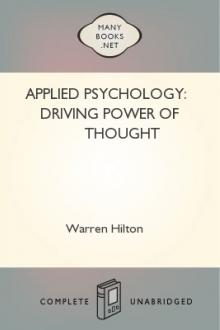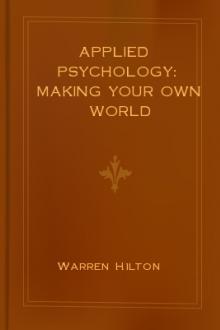Applied Psychology: Driving Power of Thought by Warren Hilton (smart books to read TXT) 📕

- Author: Warren Hilton
- Performer: -
Book online «Applied Psychology: Driving Power of Thought by Warren Hilton (smart books to read TXT) 📕». Author Warren Hilton
"Two class experiments belonged rather to the periphery of psychology.
"The exactitude of space-perceptions was measured by demanding that each divide first the long and then the short edge of a folio sheet into two equal halves by a pencil-mark.
"And finally, to measure the rapidity of movement, it was demanded that every one make with a pencil on the paper zigzag movements of a particular size during the ten seconds from one signal to another.
"After these class experiments, I turned to individual tests.
"First, every girl had to sort a pack of forty-eight cards into four piles as quickly as possible. The time was measured in fifths of a second, with an ordinary stop-watch.
"The following experiment which referred to the accuracy of movement impulses demanded that every one try to reach with the point of a pencil three different points on the table in the rhythm of metronome beats. On each of these three places a sheet of paper was fixed with a fine cross in the middle. The pencil should hit the crossing point, and the marks on the paper indicated how far the movement had fallen short of the goal. One of these movements demanded the full extension of the arm and the other two had to be made with half-bent arm. I introduced this last test because the hitting of the right holes in the switchboard of the telephone office is of great importance.
"The last individual experiment was an association test. I called six words, like 'book,' 'house,' 'rain,' and had them speak the first word which came to their minds. The time was measured in fifths of a second only, with an ordinary stop-watch, as subtler experiments, for which hundredths of a second would have to be considered, were not needed.
"In studying the results, so far as the memory experiments were concerned, we found that it would be useless to consider the figures with more than ten digits. We took the results only of those with eight, nine and ten digits. There were fifty-four possibilities of mistakes. The smallest number of actual mistakes was two, the largest twenty-nine. In the experiment on attention made with the crossing-out of letters, we found that the smallest number of correctly marked letters was 107, the largest number in the six minutes, 272; the smallest number of overlooked letters was two, the largest 135; but this last case of abnormal carelessness stood quite isolated. On the whole, the number of overlooked letters fluctuated between five and sixty. If both results, those of the crossed-out and those of the overlooked letters, are brought into relations, we find that the best results were a case of 236 letters marked, with only two overlooked, and one of 257 marked, with four overlooked. The very interesting details as to the various types of attention which we see in the distribution of mistakes over the six minutes were not taken into our final table. The word experiments by which we tested the intelligence showed that no one was able to reproduce more than twenty-two of the twenty-four words. The smallest number of words remembered was seven.
"The mistakes in the perception of distances fluctuated between one and fourteen millimeters; the time for the sorting of the forty-eight cards, between thirty-five and fifty-eight seconds; the association-time for the six associated words taken together was between nine and twenty-one seconds. The pointing experiments could not be made use of in this first series, as it was found that quite a number of participants were unable to perform the act with the rapidity demanded.
"Several ways were open to make mathematical use of these results. I preferred the simplest way. I calculated the grade of the girls for each of these achievements. The same candidate who stood in the seventh place in the memory experiment was in the fifteenth place with reference to the number of letters marked, in the third place with reference to the letters overlooked, in the twenty-first place with reference to the number of word pairs which she had grasped, in the eleventh place with reference to the exactitude of space-perception, in the sixteenth place with reference to the association-time, and in the sixth place with reference to the time of sorting. As soon as we had all these independent grades, we calculated the average and in this way ultimately gained a common order of grading. * * *
"With this average rank list, we compared the practical results of the telephone company after three months had passed. These three months had been sufficient to secure at least a certain discrimination between the best, the average, and the unfit. The result of this comparison was on the whole satisfactory. First, the skeptical telephone company had mixed with the class a number of women who had been in the service for a long while, and had even been selected as teachers in the telephone school. I did not know, in figuring out the results, which of the participants in the experiments these particularly gifted outsiders were. If the psychological experiments had brought the result that these individuals who stood so high in the estimation of the telephone company ranked low in the laboratory experiment, it would have reflected strongly on the reliability of the laboratory method. The results showed, on the contrary, that these women who had proved most able in practical service stood at the top of our list. Correspondingly, those who stood the lowest in our psychological rank list had in the mean time been found unfit in practical service, and had either left the company of their own accord or else had been eliminated. The agreement, to be sure, was not a perfect one. One of the list of women stood rather low in the psychological list, while the office reported that so far she had done fair work in the service, and two others, to whom the psychological laboratory gave a good testimonial were considered by the telephone office as only fair.
"But it is evident that certain disagreements would have occurred even with a more ideal method, as on the one side no final achievement in practical service can be given after only three months, and because on the other side a large number of secondary factors may enter which entirely overshadow the mere question of psychological fitness. Poor health, for instance, may hinder even the most fit individual from doing satisfactory work, and extreme industry and energetic will may for a while lead even the unfit to fair achievement, which, to be sure, is likely to be coupled with a dangerous exhaustion. The slight disagreements between the psychological results and the practical valuation, therefore, do not in the least speak against the significance of such a method. On the other hand, I emphasize that this first series meant only the beginning of the investigation, and it can hardly be expected that at such a first approach the best and most suitable methods would at once be hit upon. A continuation of the work will surely lead to much better combinations of test experiments and to better adjusted schemes."
Analytical test studies such as the foregoing form an almost infallible means for finding out the unfit at the very beginning instead of after a long and costly experimental trying-out in vocational training-school or in actual service.
Whatever your line of business may be, you may rest assured that an analysis of its needs will disclose numerous departments in which specific mental tests and devices may be employed with a great saving in time and money and a vastly increased efficiency and output of working energy.
Suppose that you are the manager of a street railroad employing a large number of motormen. Would it not be of the greatest value to you if in a few moments you could determine in advance whether any given applicant for a position possessed the quickness of response to danger signals that would enable him to avoid accidents? Think what this would mean to the profits of your company in cutting down the number of damage claims arising from accidents! Some electric railroad companies have as many as fifty thousand accident indemnity cases per year, which involve an expense amounting in some cases to thirteen per cent of the annual gross earnings. Yet a comparatively simple mechanism has been devised for determining by the reaction-time of any applicant whether he would or would not be quick enough to stop his car if a child ran in front of its wheels.
The general employment of this test would result in the rejection of about twenty-five per cent of those who are now employed as motormen with a correspondingly large reduction in the number of deaths and injuries from street-car accidents. And on the other hand, the general use of psychological tests in other lines of work would make room for these men in places for which they are peculiarly adapted and where their earning power would be greater.
If, for example, the applicant responds to the signs of an emergency in three-fifths of a second or less, and has the mental characteristics that will enable him at the same time to maintain the speed required by the schedule, he may be mentally fitted for the "job" of motorman; while if it takes him one second or more to act in an emergency, he may be a dangerous man for the company and for the public.
Two-fifths of a second difference in time-reactions may mark the line between safety and disaster. How absurd it is to trust to luck in matters of this kind when by means of scientific experimental tests you can accurately gauge your man before he has a chance to involve you or your company in a heart-breaking tragedy and serious financial loss!
You can readily see that very similar tests could be devised to meet the needs of the employer of chauffeurs, as,





Comments (0)